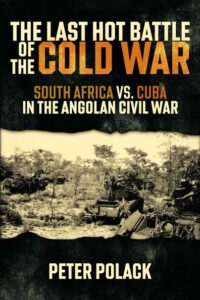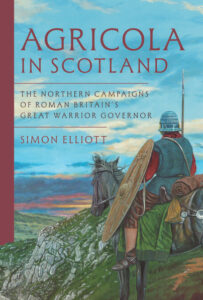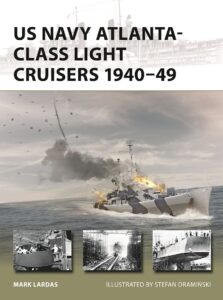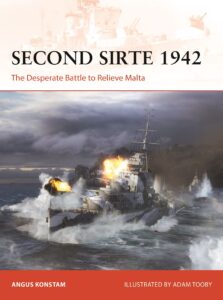
by RNS | Jul 29, 2025 | Beating Tsundoku
Peter Polack, The Last Hot Battle of the Cold War (Casemate, 2025)
The Battle of Cuito Cuanavale was fought between South African/UNITA and Cuban/FAPLA troops in Angola over a seven month period from August 1987 to March 1988. This was a wide-ranging battle fought over nine-thousand square miles of southern Angola, making it the second largest battle on the African continent after El Alamein. First published in 2013 and now reproduced as a paperback by Casemate, Peter Polack’s The Last Hot Battle of the Cold War tells the gripping story of an intense battle in a crucial phase of the Angolan Civil War.
BUY NOW
Polack outlines the background of the conflict, which erupted from Angola’s independence from Portugal in 1975. The main parties that fought for control were the communist backed MPLA, the US backed UNITA, Cuba, and South Africa. The civil war culminated in the two-part Battle of Cuito Cuanavale. The MPLA’s armed wing was FAPLA, originally led by Soviet advisors who planned the ill-fated attack across the Lomba river. That led to a disastrous retreat followed by a stout defence of Cuito Cuanavale, aided by Cuban forces, against a South African advance. Polack considers the Cuban and South African forces that fought in Angola, including Cuba’s dominance in air power and South African improvisation and innovation. After a brief summary of the Soviet advisors in Angola, Pollack turns to the Angolan FAPLA and UNITA forces and their development. A longer aside follows on the career of General Ben Ben of UNITA before Polack enters the narrative.
In Spring 1987, FAPLA initiated a build-up of forces around Cuito Cuanavale. That is where Polack begins his story. An initial advance of FAPLA, dogged by problems but partially successful, crossed the Lomba river then ran into a South African and UNITA buzzsaw of infantry and artillery fire. In the intense fighting that followed hundreds of FAPLA were killed and wounded. Polack interrupts his narrative with a brief biography of South African Commandant Robbie Hartslief, but he is soon back into the action with the retreating FAPLA pursued by the South Africans. Both sides then settled in for the siege of the town of Cuito Cuanavale. Polack makes it clear that the Soviet advisors to FAPLA had proved disappointing. It would be left to the Cubans to bail them out, which they did through advice, training, effective command, and forces on the ground. Polack provides a blow by blow account of the siege, including chapters on the air war, casualties, and prisoners of war. In December 1988, a ceasefire was signed, which brought about the withdrawal of Cuban and South African forces. But the repercussions continue with Polack highlighting the ongoing process of clearing landmines. Various lists of officers and men involved in the fighting closes out Polack’s book.
Polack has written a book packed with information about a conflict still too few know about. He also captures the spectrum of experience from the top commanders to the soldiers in the field, some of whom paid too high a price for poor decision making by those commanders. There are places where Polack disrupts the flow with digressions that could have been footnoted, and the ratio of narrative to information could have been better weighted, but once Polack gets into the narrative, his descriptions of ground combat are often harrowing, and he provides the reader with a sense of being there; for example, trapped in a South African armoured vehicle with a T-55’s turret slowly turning, or in an FAPLA trench as the artillery rained down, or just being in the sensory-depriving heat of Angola with potential death all around. Some of his selected quotes from the combatants are as authentic as any you will read in military history. Despite the asides and diversions, this book was well worth Casemate’s effort in bringing Angola to a wider readership.

by RNS | Jul 18, 2025 | Beating Tsundoku
Simon Elliott, Agricola in Scotland (Pen & Sword, 2025)
According to Simon Elliott, Gnaeus Julius Agricola was Roman Britain’s greatest warrior governor. Perhaps. It is a bold statement and one that drives Elliott’s analysis in his latest book, Agricola in Scotland. Elliott sets up the imperial context for Agricola’s governorship of Britain, from 77 to 83 CE, while along the way he describes many of the elements behind that fascinating story of conquest.
Elliott begins with some Roman history 101, providing general context for the empire and the provinces, particularly Britain. This includes a glossary of key terms used in the book. After a chapter with an overview of the Republic and Principate Empire, Elliott digs into the Roman military system, again working from the most basic level. This covers the Legions and Auxiliaries, their weapons and armour, and the regional fleets. He moves onto a general description of Roman Britain in the later First Century CE, including its geography, which would prove so important in Agricola’s campaigns. Elliott also surveys the British tribes’ ways of life and their common way of war. An interesting aside here is a discussion of the weather, where Elliott asserts the Roman view that Britain was ‘wet and cold’, a seemingly obvious statement but one that may have had important military ramifications. Elliott discusses the various Roman campaigns from Caesar’s arrival to Boudicca’s rebellion in 60 CE then pauses to outline Agricola’s early life and his rise to prominence. Elliott returns to Boudicca’s rebellion, where we find Agricola serving with Governor Paulinus in north Wales. Paulinus rushed south and defeated Boudicca then left Britain with Agricola, who subsequently served in Asia, Spain, and Rome. Elliott delves into the year of the four emperors, 69 CE, and its favourable impact on Agricola, who picked the winning side and received a promotion to command a legion in Britain.
BUY NOW
The second half of Elliott’s book follows Agricola into Scotland. Elliott notes the expansionist policy of the Flavian emperors set against the psychological impact of the Varian military disaster in 9 CE. Agricola arrived in Britain, which was in turmoil because of mutinous legions. He helped calm the waters and served under two governors before becoming governor himself, with an intervening consulship in Rome. Elliott then describes the role of a Roman governor. Agricola arrived in Britain in 77 CE and immediately went to work reducing Wales and the north of England. Then he marched into Scotland. Elliott surveys the northern lands and the tribes facing Agricola and his army. Elliott stresses the importance of marching camps for following Agricola’s movements. This he proceeds to do over the course of four campaigns leading to the Battle of Mons Graupius. Along the way, Elliott discusses amphibious operations, the aborted invasion of Ireland, and Roman siege-craft. He describes the battle and its aftermath within the contexts of the Romans in Scotland and the emperor Domitian’s rise and fall.
Elliott does well to place Agricola and his campaigns into the broader imperial context, and his introductory material on the legions and Celtic warfare is useful for novice readers in the period, as is his grasp of the naval aspects of the campaigns. Readers familiar with Agricola’s campaigns in Scotland, however, will find very little new information in this book. Indeed, only about one-third of the text directly relates to Agricola in Scotland, and, in the end, Elliott falls back on a well-trodden narrative path for the campaigns and the Battle of Mons Graupius. But that is a story full of cracks that Elliott papers over, which is disappointing, and he spends little time considering alternative sites. Nevertheless, readers new to the Agricolan campaigns will find Elliott’s book a useful gateway into a fascinating, albeit brief, period in the history of Roman Britain.

by RNS | Jul 6, 2025 | Beating Tsundoku
Mark Lardas, US Navy Atlanta Class Light Cruisers 1940-49 (Osprey, 2025)
Imagine being a Japanese pilot in 1943 attempting to sink a US aircraft carrier, but there is a cruiser in the way, and it is throwing an awful lot of lead up at you. If that cruiser was an Atlanta class, you would probably be rethinking your career choice. This was one of the USN’s most effective anti-aircraft ships, and Mark Lardas tells us about them.
So much of the origin stories for warships in World War II lay in the restrictive naval treaties of the inter-war years. This was particularly true for the development of cruisers. For the US, that led to the introduction of the multi-mission Atlanta class, weighing in at about 7,400 tons and festooned with weapons. Lardas highlights the criteria for the new Atlanta class ships: tonnage and speed, with armament a lower priority. He notes that the biggest weakness was instability because of their high smokestacks and stacked gun batteries. The Atlantas carried the most effective dual-purpose guns of WWII, the 5in./38cal DP guns, in eight turrets, supplemented by 1.1in and Oerlikon 20mm close-range guns, Mk15 torpedoes, and twin depth charge racks placed at the stern. The US built four Atlantas then almost immediately ordered four more as the Oakland subclass, which were orientated more towards the anti-aircraft role. The USN then built the Juneau subclass based on lessons gleaned in the Pacific Theatre. These were pure anti-aircraft ships with many changes but still based on the Atlanta design. Lardas also illustrates the changes to the ships throughout the war, which made no two of them quite the same. Eight of the Atlantas served in the Pacific, with two, the Atlanta and Juneau, being sunk off Guadalcanal. Throughout the war, however, they fulfilled their purpose of throwing lots of lead into the air to foil Japanese aircraft. Their post-war service was short-lived in the new jet aircraft generation; one fought in the Korean War while some remained mothballed through the 1950s before being scrapped.
Lardas has written an informative survey on a very useful class of ships, even though they excelled in a role for which they were only partly designed. He is ably supported by Osprey’s usual high quality graphic design and selection of photographs. It is unfortunate that none of these elegant ships survive, but Lardas’s history of them adequately keeps the Atlanta class from being forgotten. Anyone interested in the USN during the Pacific War will appreciate this book.

by RNS | Jul 4, 2025 | Beating Tsundoku
Angus Konstam, Second Sirte 1942 (Osprey, 2025)
The Gulf of Sirte was the north-African terminus for Axis supplies from Italy. The British had to interrupt that supply line, but to do that effectively, they had to protect their bastion of Malta, which they also had to supply. Thus, two supply lines crossed, and whoever controlled them would win the war in the Mediterranean. In his latest book in the Osprey Campaign series, Angus Konstam argues that the British problem was greater because the Axis controlled the skies and operated from home bases. In December 1941, a British convoy got through to Malta, just. In March 1942, they tried again despite being outnumbered and outgunned.
Konstam sets off the Battle of Second Sirte against the backdrop of the continuing struggle for control in the Mediterranean. That had favoured Britian, especially after the victory over the Italians at Matapan in March 1941. Then came the German invasion of Greece and the Allied loss of Crete with significant losses to the Royal Navy. The pendulum had swung, with the German luftwaffe in particular causing the British headaches. The Italian fleet was also still powerful, despite their losses in the raid on Taranto, but the RN held the advantage in radar, deterring the Italian fleet from nighttime engagements. Still, getting convoys through to Malta was imperative however risky that would prove to be, especially during the day.
Admiral Sir Andrew Cunningham commanded the Mediterranean fleet, with Rear Admiral Sir Philip Vian his able subordinate. The Italian Regia Marina was commanded by Admiral Angelo Iachino assisted by Ammiriglio di Divisione Angelo Perona, but both laboured under restrictive orders from their superiors in Rome. Konstam discusses the disparity in the respective fleets, noting that the RN was deficient in carriers, battleships, and heavy cruisers, and what they had was not all that great. But the RN had radar, effective gunnery, and professionalism, whereas the Regia Marina had the resources but not the wherewithal on how to use them effectively
Konstam moves onto the action after describing the respective battle plans, which amounted to the British moving a convoy over 900 miles, and the Italians, with German luftwaffe and U-boat assistance, trying to stop them. The convoy sailed on Friday, 20 March 1942, but did not see serious action before Sunday morning. Then the air attacks and the Italian fleet arrived to which the RN countered with a wall of smokescreen. The fleets exchanged gunfire, broke off, manoeuvred, then engaged again in a sprawling melee fought at times in near gale-force conditions. In the end, the Italian fleet turned for home as night fell. Despite constant air attacks, most of the convoy made it to Malta. However, they were still not safe from the luftwaffe, which sunk or damaged all of the ships.
The story of the Battle of Second Sirte is a confusing one, but Konstam narrates it well, and along with some excellent maps, brings clarity to the combat. Konstam not only coordinates the action but brings out the reasons why the battle transpired as it did, and the reader cannot help but admire the daring and resolve of the outgunned RN ships and their crews. It would have been interesting to know what the latter thought of it all, but the Campaign series format allows for not much more than an operational level overview. Konstam provides a useful further reading list, however, for those wanting to read more. Overall, Second Sirte is a worthwhile addition to the Campaign series, and the prolific Konstam is always worth reading.





